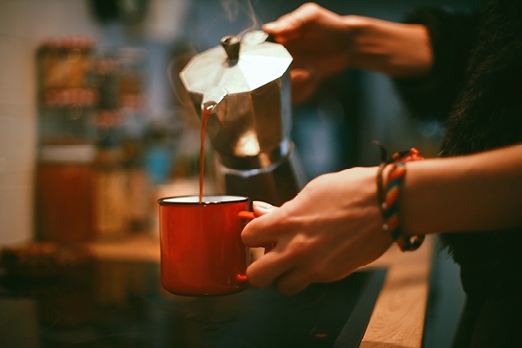What’s the best coffee for an Americano?
An intriguing journey into the history of the Americano, born during World War II thanks to American soldiers in Europe. From the sweet notes of South American beans to the aromatic varieties of Africa, discover how choosing the right coffee can make this beverage a unique experience.

Like many Nando Moricone, post-World War II saw many Italians living the American dream. The iconic Alberto Sordi enchanted audiences in his comedy film “An American in Rome,” portraying an Italy experiencing post-war rebirth, continually imitating a lifestyle that wasn’t ours but was idealized. Even a quintessentially Italian product like coffee saw the rise of a new format during those years, inspired by those Americans who had a hard time understanding our espresso.
Yes, we’re talking about the Americano, but not the one wandering through the Roman alleys with his sweet ‘Elvy,’ dreaming of a trip to the United States. Instead, we’re delving into the fragrant, long, and aromatic version that we can savor in a cup.
The Americano, or American coffee, gained popularity during World War II when American soldiers in Europe diluted Italian espresso with water to create a beverage more similar to the coffee they were accustomed to. This practice quickly spread and became known as “caffè americano.” Today, the Americano is appreciated for its delicacy and balanced flavor, a result of the combination of coffee and hot water.
The best coffee for an Americano should have low acidity, sweet notes, and a medium body. As for the roast, a medium roast is preferable to preserve the flavors and ensure a harmonious beverage.
PREPARATION: FROM DILUTION TO THE ART OF BREWING
In the United States, American coffee has become a true art form. Often prepared with drip coffee machines or alternative brewing methods like the French press, the goal is to achieve a balanced, aromatic, and slightly diluted cup. Americans appreciate the wide range of coffee beans available, contributing to the creation of a rich and diverse coffee culture. In this sense, Americano is somewhat synonymous with filtered coffee, but we strongly advise always using the latter term to avoid confusion.

Indeed, Americano defines a specific preparation that starts with the intensity and aromatic concentration of an espresso, providing lightness and harmony with the addition of hot water. Perfect for a #Cheerful Character, Americano is the ideal beverage to accompany long moments throughout the day. With its great balance between strength and elegance, it offers enjoyable breaks between tasks. It manages to extend the aromatic pleasure of an espresso, combining the delicate body of a filter coffee.
WHICH COFFEE?
As it involves adding hot water to espresso, in Italy, attention is focused on the quality and intensity of the base espresso, while in America, they are more attentive to the variety of coffee beans. However, even along the Italian peninsula, something is changing, and the careful selection of the blend to use in preparation is gaining more importance.
If we emphasize the espresso, it is better to consider a blend of different origins and, especially, varieties, perhaps one with a #Fascinating Character. Thanks to a low percentage of robusta, it provides a full-bodied, slightly sweet coffee with a enveloping crema, maintaining a great aromatic balance due to the remaining arabica.
Choosing a single-origin preparation significantly influences the aromatic profile and final taste. Coffee beans from specific regions around the world offer unique flavor profiles. You can make a choice based on these indications:
- South American origins: coffees from South American countries such as Brazil, Colombia, and Costa Rica often bring notes of hazelnut, cocoa, and citrus to the cup. Their moderate acidity and balanced sweetness integrate beautifully with the addition of hot water, creating rich and enveloping Americanos.
- African Varieties: African beans, like those from Ethiopia or Kenya, carry floral, fruity, and spicy aromas. These coffees offer lively acidity, which, when slightly diluted, contributes to creating vibrant and complex Americanos.
- Asian Beans: Asian coffees, for example, those from Sumatra or Vietnam, can provide unique depths with woody, spicy, and sometimes chocolaty notes. Perfect for #Vigorous Characters, these beans, when diluted, create robust and character-rich Americanos.
The beauty of the Americano lies in its great adaptability to coffee beans. In our top 3 for a good Americano, Brazil stands out with its sweet and creamy profiles, Colombia is famous for fruity and floral aromas, and Indonesia offers full-bodied coffee.
Since the extraction requires high pressure concentrated in a few seconds, coffee must undergo a medium roast, which manages to emphasize the warm and toasty notes of the beans, reducing the potential acidity that, instead, is enhanced by a light roast. Dark hazelnut-colored beans maintain body and robust notes, preventing them from dissipating even when the beverage is diluted with water.

DID COFFEE OR HOT WATER COME FIRST?
This unresolved dilemma of centuries—precisely, did coffee or hot water come first? We jest, but there’s a kernel of truth in this question: which ingredient should be poured first into the cup? Usually, hot water takes precedence, into which our espresso is poured (or directly extracted), typically double. This way, the espresso’s crema will stay on the surface; some prefer this method because they enjoy seeing the crema, while others prefer to eliminate it for an even cleaner product. However, if you’re unsure about how much to dilute your coffee, you can extract it into a very large cup and keep the boiling water in a small pitcher, adding it gradually until reaching the preferred density.
Ordering it at the bar will save you a lot of effort: the professionalism of a barista will bring you an excellent cup starting from skillfully ground beans, extracted with a perfect ratio of water to ground powder, and finally diluted with the right water (which is always an ingredient, had you ever thought about it?) But if you want to try it at home, who are we to stop you? In fact, we leave you our heartfelt recipe for a good Americano:
- Grinding: Start by grinding the coffee beans just before preparation to preserve their freshness and aroma.
- Dosage: Use about 7-8 grams of ground coffee for each espresso. Then, prepare a double espresso with 16-17 grams of ground coffee.
- Extraction time: Classic espresso, so about 25-30 seconds for a perfect extraction (the coffee that descends “mouse-tail,” you know, right?). You’ll get about 50 ml of coffee.
- Service: Pour the coffee into a pre-warmed cup full of hot water. There’s no correct ratio; to start, try 1:4 (one part espresso and four parts water) and then decide based on your preferences.
Enjoy it (if possible) without sugar or milk to fully appreciate its nuances.
Following these simple steps and choosing the right coffee, you can prepare a delicious Americano that will satisfy even the most discerning palates. We recommend that when offering a great Americano to a friend, always be careful to specify that it is coffee; confusing it with the iconic cocktail is quick… and you wouldn’t want to be mistaken for the revelers of 9 in the morning, right?
Ready to join the Vinhood family?
Vinhood is the First Italian Taste Agency. We explore the world of taste to guide people about how to choose and consume products and supporting companies in nurturing personalized relationships with their customers.
Read more
- Ok Google, find a coffee bean ideal for a homemade cappuccino!
 In times of coronavirus, we are deprived of most of our comfortable habits, forced to find most of our solutions online. Though, looking at things from the bright side, it has allowed us to try new things...
In times of coronavirus, we are deprived of most of our comfortable habits, forced to find most of our solutions online. Though, looking at things from the bright side, it has allowed us to try new things... - The ABCs of perfect moka
 Morning rituals revolve around various beverages, but we can safely say that for approximately 90% of Italian families, the moka pot steals the show. Let’s learn everything about it!
Morning rituals revolve around various beverages, but we can safely say that for approximately 90% of Italian families, the moka pot steals the show. Let’s learn everything about it! - 4 places in Milan to find inspiration with specialty coffee
 Specialty Coffee, a worldwide trend that has taken Milano. Allow it to inspire you and delight your senses by visiting this wonderful coffee bars and try their exquisite coffee.
Specialty Coffee, a worldwide trend that has taken Milano. Allow it to inspire you and delight your senses by visiting this wonderful coffee bars and try their exquisite coffee.

